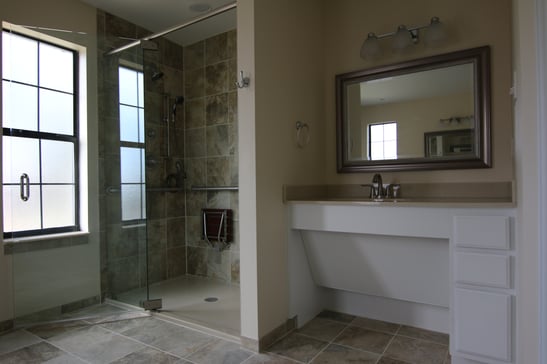The Center for Disease Control defines aging in place as the ability to live in one’s own home and community safely, independently, and comfortably regardless of age, income, or ability level. Aging in place construction and remodeling has become synonymous with handicap accessible home design and modification during our lifetime. Home modifications can be used to accomodate anyone from people with mobility impairments to those with vision loss, hearing loss, or even cognitive or developmental disabilities. Accessibility home modifications or wheelchair accessible kitchen and bathroom remodeling in Austin will allow anyone with limited mobility within your home to feel more empowered and independent. The extent of a customized accessibility design is dependent upon the activity level of the person requiring the modifications. Whether someone needs a cane, walker, or wheelchair to help with mobility it is definitely a game changer for accessibility within the home. Aging in place home modifications help people maintain their living environment for as long as it works for them before they might need assisted living care or a nursing home.
Some people confuse aging in place with universal design. Both are a method to increase accessibility within the home but aging in place strictly deals with an existing home. Aging in place design also implies modifying any home for it's older occupants to insure that the inhabitants can safely remain there as long as they possibly can. This time will expire once they need assisting medically trained help for safeguarding their personal safety in a nursing home or an assisted living environment. Universal design is just that; offering choices to all of a home's residents no matter their age or physical capabilities. It begins with a design and then the construction begins. The number one safety hazard for elderly people is negotiating level changes within the home--steps at the entry, stairs between floors, and curbs to step over when entering the bath or shower. Eliminating level changes is very difficult in existing homes and almost impossible to do aesthetically and without major compromises, unless there is a major renovation. The result is that most homeowners decide to sell the house rather than make the modifications. When universal design is incorporated into their design, homes can accommodate the needs of their owners as those needs evolve over time.
Baby boomers in their 50's today are mostly in denial. They generally believe that their way of life and their personal mobility are a constant. They believe they are invincible--especially older men who will always say they don't need those types of modifications in their house. Women in their 60's, on the other hand, seem to face facts differently acting as the caretaker of their home. They not only watch out for the safety of themselves but for the other family members. This is good because someone needs to be the decision maker when faced with life altering changes and what can be done about them. The caregiver usually guides the husband into realizing that home modifications are good for everyone's safety.
Physical limitations affect many more people than the daily users of walkers and wheelchairs and bathroom modifications for the elderly is a sign of the times. Many members of our life experienced or elder society have significant problems in dealing with their home environment. Today's conventional building standards conflict with most people's accessibility when you consider our created architectural barriers concerning cabinetry and door opening widths, individual strength, range of motion, movement, manual dexterity, balance, and coordination . Once the demands of our built environment exceed their capacities we become excluded from a room or even the entire home. The building world must work in unison to be sure the entire living environment meets basic needs in addition to affordability and structural integrity for the consumer and home owner. This includes both the home and the components within the home being accessible to all inhabitants. This will certainly require the expertise of an aging in place specialist Austin, Texas. Privacy, sense of belonging, sense of control, and the sense of safety and security make up the quality of life for any home and should be considered for any design.
The three main rooms involved in aging in place design and home modifications are the bathroom, the kitchen, and the family room in that order. These areas make up the most occupied spaces of any home and will be connected by a designated accessible route. Here we will need access through wider doorways, non slip floor surfaces, and adequate cabinet and plumbing fixture accessibility. What is more important is that we must observe safety for everyone as the baby boomers choose to age in place within their homes. Just remember one thing and dispel any myth that aging in place construction and remodeling must appear institutional or out of the ordinary. When the work is done with style and taste it will only compliment the home.
Aging In Place Vanity With Accessibility













